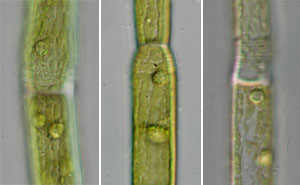| NIES-MCC | KU-MACC | Tree to Strain | Japanese | English |
| Life / Eukarya / Plantae / Viridiplantae / Chlorophyta / Chlorophyceae / Oedogoniales / Oedogoniaceae | |

|
Oedogonium Oedocladium Bulbochaete |
| * Dotted lines indicate they may be polyphyletic | |
| Reference |
|
|
The Oedogoniales is a common filamentous green algal group in freshwater. They usually attache to substrate by holdfast cells, but sometimes free-floating. Oedocladium is terrestrial. Chloroplast genome sequence is reported for Oedogonium cardiacum (Jean-Simon et al. 2008. BMC Genomics 9: 290). Filamentous thalli are branched or unbranched. Each cell is cylindrical, vacuolated, uninucleate, and possesses a parietal reticulate chloroplast. The chloroplast includes many pyrenoid invaginated by numerous, branched, cytoplasmic channels. Bulbochaete possesses colorless hair cells. Flagellate cells (zoospores and sperms) are stephanokont (having many anterior flagella arranged circularly). One daughter nucleus moves to the end of the cell after mitosis. The septum is generated by phycoplast and cell plates between the doughter nuclei. At the end of the mother cell including one doughter nucleus, new lateral cell wall brakes into the mother cell wall and this process generates characteristic rings at the end of the cell. Asexual reproduction by means of zoospores, but fragmentation of filaments, aplanospores and akinetes are also known. Sexual reproduction by means of oogamy. Thalli are monoecious or dioecious forming antheridium and/or oogonium. Some dioecious species produce androspores that chemotactically attache and form small male gametophytes (dwarf males) near oogonium (nannandrous). Other dioecious species have the male gametophytes simillar to female in size (macrandrous). The zygote becomes resting oospore and usually releases four zoospore via meiosis. |
 Oedogonium sp. |